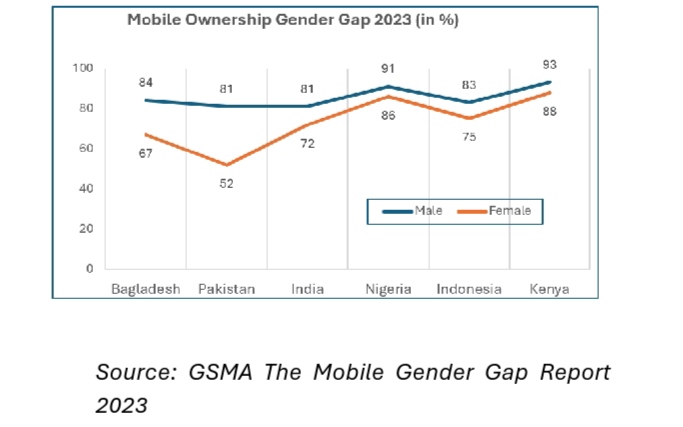By Parvez Iftikhar
As a father of three brilliant daughters, I am a strong proponent of women’s education and the women contributing to the national economy. In this context, I feel incredibly concerned that most of my country-women cannot make use of that formidable force that can transform women’s lives – the internet.
A survey by GSMA (GSM Association) revealed that 46% of female owners of mobile phones in Pakistan report that even a simple mobile phone provides access to helpful information they would not otherwise be able to obtain. Free of spatial constraints, women can now educate themselves on any subject – from health and legal rights to academic pursuits. Online courses and educational resources have opened doors for women to enhance their skills and pursue further education, irrespective of geographical and other restrictions.
Online businesses and freelancing opportunities empower women to work from home, overcoming traditional barriers. The internet has catalysed economic independence, allowing women to harness their skills and talents to create successful ventures. This connectivity extends beyond personal relationships to professional networking, creating opportunities for mentorship and career advancement.
Online resources provide information on healthcare, reproductive rights, and mental health. Moreover, the internet amplifies voices, allowing activists to reach a broader audience, raise awareness, and advocate for change.
Digital financial services and mobile banking empower women to take control of their finances. Financial independence contributes to greater autonomy and empowerment.
Challenges
While the internet is bringing about significant positive changes for women, it’s essential to acknowledge the challenges holding half the nation back. With vast numbers of women in rural, or low-income urban, areas not having equal access to online resources. And so the digital gender gap persists. According to PTA, out of 122.9 million mobile broadband subscriptions till June 2023, only 29.8 million belonged to women.
According to the GSMA Mobile Gender Gap Report 2023, Pakistan has the widest gap in mobile ownership in South Asia, where women are 35% less likely to own a mobile device.
Owning a phone is only the first challenge. The male head of the household will find every excuse in the world not to allow his sister/wife/ daughter to have her mobile phone. The most common excuse is, “She will waste her time”.
If she does get permission to own a phone, in all likelihood, she cannot go to a shop and have herself biometrically verified to get her own SIM. At times, she does not have a CNIC. Our housemaid could not get one from NADRA because she had no birth certificate. NADRA gives her the option of bringing her parents over to vouch for her, which they cannot afford because they live too far away. Their health does not allow them to travel. Thus, phone subscriptions of many women are in the names of their fathers/brothers/husbands.
Next comes the subscription and use of the internet itself. In developing countries, smartphones are the most used devices for internet access. But, due to their cost, the smartphone is a barrier to entry into the internet world.
Some women overcome even the affordability challenge and manage to get hold of smartphones with data subscriptions. Thankfully, mobile internet tariffs in Pakistan are among the lowest in the world.
For most Pakistani women, the first use of the internet is always for family connections.
It is after this that the challenge of lacking digital skills appears. In parallel, they still have to deal with online harassment, which impacts women disproportionately more than men.
Positive Efforts
Recently, GSMA reported that Pakistan is one country where the gender gap in mobile internet usage is reducing – unlike India and Bangladesh. Tremendous efforts by several organisations and NGOs are behind this.
One significant effort is PTA’s “Digital Gender Inclusion Initiative”, run by an all-women-empowered digital gender inclusion committee. The initiative focuses on five critical areas aligned with GSMA’s policy considerations: affordability, knowledge and digital skills, safety and security, access, and relevance. Smaller initiatives within the overall scheme include improving affordability, enhancing digital literacy, ensuring online safety, promoting access, and developing locally relevant content. In collaboration with UNESCO, PTA also launched a Gender Inclusion strategy during the Mobile World Conference in Barcelona.
In its efforts, PTA has the commitment of the mobile industry players. They have committed special tariff packages for gender-specific projects, low-cost phones with built-in female-specific user-friendly apps, etc. Mobile operators also endeavour to educate women users in basic digital skills, entrepreneurship, health, content creation, and financial inclusion.
PTA could have restricted itself to the role of a typical sector regulator, but it is commendable that it chose to do more than just that. Others should follow the example.

